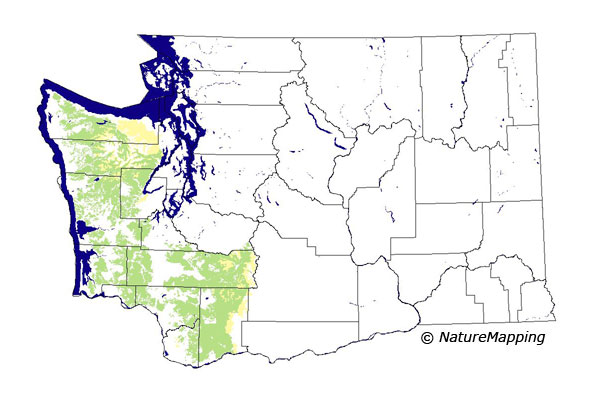GAP Analysis Predicted Distribution Map
Cope's Giant Salamander (Dicamptodon copei)
Species Code: DICO
|
Legend:
 = Core Habitat = Core Habitat
 = Marginal Habitat = Marginal Habitat
Metadata
(Data about data or how the map was made)
Predicted Distribution
Amphibians do not migrate as some birds and mammals, so the colored areas depict the predicted range for the Cope's Giant Salamander year-round. The habitats were identified using 1991 satellite imagery, other datasets and experts throughout the state, as part of the Washington Gap Analysis Project.
Click to enlarge distribution map
|
Distribution and Habitat Requirements
Cope's Salamander is restricted to streams and seepages in moist coniferous forests west of the Cascades.
The species is associated with small streams in primarily coniferous forests.
Models
The Olympic Peninsula, Southwest Cascades, Willamette Valley and the western portion of the Puget Trough ecoregions were selected.
The Western Hemlock and silver Fir zones were core in these ecoregions, except on the western edge of the Southeast Cascades where Western Hemlock was marginal. the Sitka Spruce zone was, core, while the Puget Sound Douglas-fir, Olympic Dopuglas-fir, Interior Western Hemlock, Subalpine fir, Mou ntain Hemlock, Woodland/Prairie Mosaic, Cowlitz and Willamette Valley zones were marginal.
In the high zones, riparian habitat was good. In the low zones, conifer-lined riparian habitat was good.
In all zones, conifer forests were suitable if appropriate microhabitats existed.
Location data indicate that this species is usually in hilly terrain in moist to wet zones.
Translated from the Washington Gap Analysis Amphibians and Reptiles Volume by Karen Dvornich
Webpage designed by Dave Lester

 = Core Habitat
= Core Habitat = Marginal Habitat
= Marginal Habitat